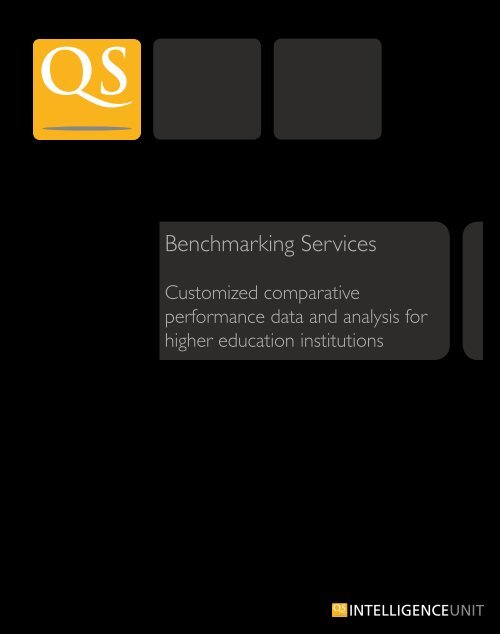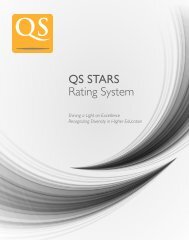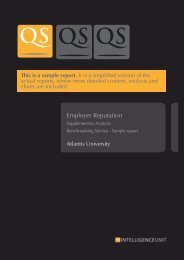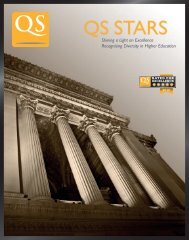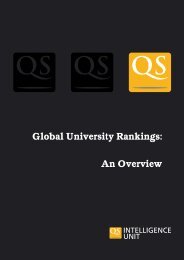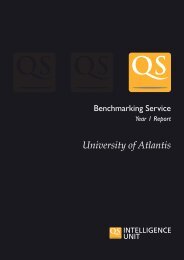Benchmarking Services - QS Intelligence Unit
Benchmarking Services - QS Intelligence Unit
Benchmarking Services - QS Intelligence Unit
You also want an ePaper? Increase the reach of your titles
YUMPU automatically turns print PDFs into web optimized ePapers that Google loves.
<strong>Benchmarking</strong> <strong>Services</strong><br />
Customized comparative<br />
performance data and analysis for<br />
higher education institutions
<strong>QS</strong> Quacquarelli Symonds<br />
<strong>QS</strong> Quacquarelli Symonds was founded in 1990 and has established itself as the leading global provider of specialist<br />
higher education and careers information and solutions. The company’s mission is to enable motivated people around<br />
the world to fulfil their potential by fostering international mobility, educational achievement and career development.<br />
<strong>QS</strong> offers market-leading services to the higher education community around the world, unmatched by our competitors<br />
in range, innovation, quality and client satisfaction.<br />
An independent audit of the company conducted by Paramarq in December 2010 found:<br />
• 97% of <strong>QS</strong> clients were fairly/very satisfied with <strong>QS</strong> services<br />
• Over 85% of <strong>QS</strong> clients would recommend <strong>QS</strong> to colleagues<br />
We are headquartered in London with major offices in Paris,<br />
Stuttgart, Singapore and New York City, as well as satellite offices<br />
in Beijing, Sydney, Boston, Washington DC, and Johannesburg.<br />
We work closely with major institutions, government bodies and<br />
over 300 different global media outlets worldwide.
<strong>QS</strong> <strong>Intelligence</strong> <strong>Unit</strong><br />
The <strong>QS</strong> <strong>Intelligence</strong> <strong>Unit</strong> (<strong>QS</strong>IU) was formed in 2008 as a distinct and autonomous department in order to meet<br />
the increasing public interest for comparative data on universities and organizations, and the growing demand for<br />
institutions to develop deeper insight into their competitive environment.<br />
Building on over 20 years of collecting institutional data, beginning with a global survey of MBA employers, our portfolio<br />
of research projects include the <strong>QS</strong> World University Rankings ® , which has been in existence since 2004.<br />
With over 20 team members in the London and Singapore offices, <strong>QS</strong>IU is a highly skilled and culturally diverse team.<br />
Quick Stats About Us...<br />
700 universities in the <strong>QS</strong> World University Rankings<br />
130 clients in <strong>QS</strong>IU’s portfolio<br />
25 countries our clients span<br />
17 languages spoken in the <strong>QS</strong>IU offices<br />
8 years since the <strong>QS</strong> World University Rankings has been in existence<br />
Visit us at www.iu.qs.com<br />
Trusted • Independent • Global
<strong>QS</strong> World University Rankings ®<br />
The <strong>Benchmarking</strong> Service utilizes the core data which<br />
has been collected over a period of nine years for the<br />
<strong>QS</strong> World University Rankings. The ranking presents a<br />
multi-faceted view of the relative strengths of the world’s<br />
leading universities.<br />
Methodology<br />
Six indicators are drawn together to form an international ranking of universities:<br />
Academic Reputation<br />
A global survey of academics asking respondents to<br />
identify universities they consider excellent in their<br />
own broad field of knowledge.<br />
Employer Reputation<br />
A global survey of employers with experience of<br />
recruiting from universities.<br />
Citations per Faculty Member<br />
Utilising Scopus data (the world’s largest abstract<br />
and citation database of research literature operated<br />
by Elsevier), this indicator combines research<br />
productivity and quality, taking into account the scale<br />
of an institution.<br />
Faculty Student Ratio<br />
In lieu of a globally available evaluation of teaching<br />
quality, this indicator is designed to serve as a widely<br />
available proxy for commitment to teaching.<br />
International Students<br />
Used to evaluate not only a university’s broad approach<br />
to internationalization, but to also give prospective<br />
students a feeling for an institution’s commitment and<br />
facilities for students from overseas.<br />
International Faculty<br />
This indicator supports the International Students<br />
indicator in assessing a university’s commitment to<br />
providing a global educational environment.<br />
Format<br />
<strong>QS</strong> World University Rankings can be found online at<br />
www.topuniversities.com and in print.<br />
Last year the rankings reached over 50 million viewers<br />
and received media coverage in over 1000 national and<br />
international print and online news portals.<br />
“[<strong>QS</strong> is] One of the big three ranking organisations.”<br />
The Economist, 10th October, 2011
<strong>Benchmarking</strong> Service<br />
The <strong>Benchmarking</strong> Service provides a method of<br />
measuring and comparing a university’s performance and<br />
standards with those of its peers. It highlights institutional<br />
trends by presenting robust data in an accessible and<br />
comprehensive format and has been extensively used by<br />
institutions around the world as an important tool for<br />
strategic planning and research.<br />
Advantages to Institutions<br />
<strong>Benchmarking</strong> an institution against its selected peers can provide a number of benefits.<br />
• Allow institutions exclusive access to data used for the <strong>QS</strong> World University Rankings<br />
• Help institutions understand their position regionally, nationally and globally<br />
• Provides context to assist in setting realistic and achievable targets<br />
• Challenges operational complacency<br />
• Creates an atmosphere conducive to continuous improvement<br />
• Identify gaps and weak areas to indicate what is required to improve competitiveness<br />
Methodology<br />
Institutions select a number (between 6 and 30) of target institutions from the <strong>QS</strong> World University Rankings list with<br />
which to compare themselves. A mixture of domestic and international institutions is ideal and a 3 to 5 year cycle is<br />
recommended in order to develop a comprehensive perspective.<br />
Utilizing the <strong>QS</strong> Classifications System, we are able to assist clients in choosing their peer list, which is a critical starting<br />
point for the benchmarking process. The System categorizes institutions by subject spread, size and research level.<br />
“The reports have served us to better know our strengths and deficiencies/<br />
opportunities as a teaching and research university and to take appropriate<br />
actions for improvement.”<br />
Dr. Francisco J. Cantu. Professor and Dean of the Research and Graduate Studies Office at<br />
Tecnológico de Monterrey
<strong>Benchmarking</strong> Deliverables<br />
The standard benchmarking report consists of five modules. Each module highlights different aspects of an institution’s<br />
profile and reveals a deeper insight into performance for both the client and the selected peer group. The first three*<br />
are core modules which are considered crucial to understanding ranking performance and are included in each<br />
report. For modules 4 and 5, clients may choose the Standard <strong>Benchmarking</strong> Report or customize their report by<br />
choosing from a list of conjoining modules (See page 7) which highlight a different aspect of institutional performance.<br />
Standard <strong>Benchmarking</strong> Report<br />
Executive Summary<br />
Includes a table of contents, introduction, and summarizes the key findings of the 5 modules.<br />
Module 1 – Institutional Profile*<br />
Delivers data in a variety of areas and gives a snapshot of an institution’s profile, including:<br />
• Performance in other ranking systems<br />
• Research and indicator performance - global averages for each institution<br />
• Underlying data including, if applicable, personnel, exchange, and financial data<br />
Module 2 – Comparative Analysis*<br />
Summarizes the current position of each selected institution in comparison with the client institution across all the<br />
indicators used in the latest edition of <strong>QS</strong> World University Rankings. This module provides a succinct indication of<br />
current performance, particularly areas of weakness which may help to feed into institutional strategic planning.<br />
Module 3 – Ranking Performance*<br />
Provides a deeper analysis on an indicator-by-indicator basis for the last five years, revealing insight into performance<br />
which is crucial for decision-making. This module also provides general strategic recommendations for the client<br />
institution.<br />
Module 4 - Research Performance I<br />
Analyzes the Citations per Faculty index and breaks down research habits and patterns in order to reveal institutional<br />
research productivity and citation levels. This module also highlights total citations obtained by each institution, taking<br />
account of the number of self-citations produced across the five faculty areas.<br />
Module 5 - Academic Reputation Performance I – International versus Domestic Responses<br />
Delves deeper into the academic reputation survey, breaking down total responses by international and domestic<br />
responses in the five broad faculty areas. It also highlights domestic performance against the maximum response rates<br />
available for each country in the peer group.
Conjoining Modules<br />
<strong>Benchmarking</strong> Service<br />
Year 1 Report<br />
University of Atlantis<br />
Clients are given the option to customize their <strong>Benchmarking</strong> Report according to their institutional needs. From<br />
the options below, clients may choose two or more modules to make up the full report. Please note there are<br />
prerequisites described in red below.<br />
ACADEMIC REPUTATION<br />
Academic Reputation Performance II – Further Analysis for the Client Institution Only<br />
Highlights the number of responses received by country, faculty area including narrow discipline fields, response by<br />
experience level and years in academia for the client institution. To select this module, clients will need to subscribe to Academic<br />
Reputation I (see page 6).<br />
Academic Reputation Performance III – Client Institution against their Peers<br />
The number of responses received by country, faculty area including narrow discipline fields, response by experience<br />
level and years in academia comparing the client against peer institutions. This module will also provide general<br />
recommendations for the client institution. To select this module, clients will need to subscribe to both Academic Reputation l and ll.<br />
EMPLOYER REPUTATION<br />
Employer Reputation Performance I – International versus Domestic Responses<br />
This module highlights the Employer Reputation indicator and breaks down survey responses from recruiters, analyzing<br />
domestic versus international responses.<br />
Employer Reputation Performance II<br />
An interrogation of this indicator, breaking down survey responses from recruiters including top institutions which they<br />
recruit from, main industry field of respondents, and the top field which is highly sought after. To select this module, clients<br />
will need to subscribe to the Employer Reputation l.<br />
RESEARCH PERFORMANCE<br />
Research Performance II – Further Analysis<br />
Further analysis of the Citations per Faculty index examining research habits and patterns in order to reveal institutional<br />
research productivity and citation levels. To select this module, clients will need to subscribe to the Research Performance I (see page 6).<br />
Research Performance III – Broad Subject Areas<br />
An analysis highlighting total citations obtained by each institution broken down by narrow subject areas. To select this<br />
module, clients will need to subscribe to the Research Performance I and II.
Other Rankings<br />
The <strong>Benchmarking</strong> Service is also available for the following ranking exercises:<br />
Regional Rankings<br />
The purpose of each ranking is to provide a neutral and<br />
independent comparison of the quality of universities<br />
across the region, based on a set of criteria that<br />
commonly applies to all countries involved in the study.<br />
<strong>QS</strong> World University Rankings by Subject<br />
This ranking examines the institutional strength in<br />
specific subject fields. Rankings in five key subject<br />
areas are produced: Arts & Humanities, Engineering<br />
and Technology, Life Sciences & Biomedicine, Natural<br />
Sciences and Social Sciences & Management.<br />
ASIAN<br />
UNIVERSITY<br />
RANKINGS<br />
TM<br />
Full results for these rankings can be found online at www.topuniversities.com. We also offer additional bespoke<br />
services and country reports, please contact jason@qs.com for more information or visit www.iu.qs.com/library.<br />
“Measuring institutional performance can be difficult but with the benchmarking<br />
service we were able to obtain comparative data and insight on peer institutions<br />
which helped us devise a clear strategic plan for improvement. We found the reports<br />
particularly helpful in presenting a clear and concise picture of performance based<br />
on a variety of metrics.”<br />
Professor Kevin Downing<br />
Senior Coordinator, Academic Planning and Quality Assurance<br />
City University of Hong Kong
<strong>QS</strong>IU Client Base<br />
A snapshot of our client base - At the heart of <strong>QS</strong>IU is our expertise and global footprint.<br />
Australia<br />
Bond University<br />
Griffith University<br />
James Cook University<br />
Monash University<br />
Murdoch University<br />
Queensland University of Technology<br />
RMIT University<br />
Southern Cross University<br />
Swinburne University of Technology<br />
University of Canberra<br />
University of New South Wales<br />
University of Newcastle<br />
University of Queensland<br />
University of Tasmania<br />
University of Technology Sydney<br />
University South Australia<br />
University of Wollongong<br />
Brazil<br />
Universidade Federal de Minas Gerais<br />
Colombia<br />
Universidad de los Andes<br />
Czech Republic<br />
Brno University of Technology<br />
Ecuador<br />
Universidad San Francisco de Quito<br />
Hong Kong<br />
City University of Hong Kong<br />
Hong Kong Baptist University<br />
India<br />
Amity University<br />
Indonesia<br />
King Saud University<br />
Institut Teknologi Bandung<br />
Umm al Qura University<br />
Universitas Airlangga<br />
Singapore<br />
Universitas Bina Nusantara<br />
Nanyang Technological University<br />
Iran<br />
National University of Singapore<br />
Islamic Azad University Khorasgan Branch (Isfahan) South Africa<br />
Ireland<br />
University of the Witwatersrand<br />
University of Limerick<br />
Spain<br />
University College Cork<br />
CESINE University<br />
Italy<br />
IE University<br />
Politecnico de Milano<br />
Sweden<br />
Università Cattolica del Sacro Cuore KTH Royal Institute of Technology<br />
Università di Pisa<br />
Lund University<br />
Università Ca’ Foscari Venezia<br />
Taiwan<br />
Kazakhstan<br />
Taipei Medical University<br />
Al-Farabi Kazakh National University National Taipei University of Technology<br />
Abai Kazakh National Pedagogical University National Chengchi University<br />
Korea<br />
Thailand<br />
Ewha Womans University<br />
King Mongkut’s University of Technology<br />
Kyungpook National University<br />
Thonburi<br />
Pohang University of Science and Technology Kasetsart University<br />
Sungkyunkwan University<br />
Mahasarakham University<br />
KAIST<br />
<strong>Unit</strong>ed Arab Emirates<br />
Mexico<br />
Gulf Medical University<br />
Tecnológico de Monterrey<br />
<strong>Unit</strong>ed States<br />
New Zealand<br />
Ohio State University<br />
The University of Canterbury<br />
<strong>Unit</strong>ed Kingdom<br />
Massey University<br />
City University London<br />
Saudi Arabia<br />
King’s College London<br />
Qassim University<br />
University of Central Lancashire<br />
King Abdulaziz University<br />
University of Cumbria<br />
King Fahd University of Petroleum & Minerals
Rate Card<br />
3 year total fee - US$45,000 (benchmarking against six other institutions)<br />
5 year total fee - US$75,000 (benchmarking against same six institutions)<br />
Additional institutions can be added to the benchmark list at a rate of $2,500 per institution per year.<br />
For customized benchmarking services, quotations are available on a case-by-case basis.<br />
For further information on <strong>QS</strong>IU <strong>Benchmarking</strong> please contact<br />
Head of sales - Jason Newman jason@qs.com<br />
General enquiries - Abby Chau abby@qs.com<br />
Australia, New Zealand, Canada, Scandinavia and USA - jason@qs.com<br />
UK, Ireland, Netherlands and Switzerland - Nicholas Sequeira nicholas@qs.com<br />
Asia, Middle East and Africa - Mandy Mok mandy@qs.com<br />
Italy and Turkey - Dario Consoli dario@qs.com<br />
Eastern Europe and Central Asia - Zoya Zaitseva zoya@qs.com<br />
Rest of World - Jason Newman jason@qs.com
“Specifically, we will use your information to identify institutions that could be a<br />
reference for us in key aspects, and to estimate the time we need to see changes<br />
reflected in our performance and in the perception of academics and employers...<br />
Modules 2 and 3 clearly explain where we should focus to improve in our rankings<br />
performance. The benchmarking analysis by subject areas, citations and productivity<br />
(module 4) clearly describes the current situation and impact of research activities<br />
of our University in comparison with other institutions. The same kind of clarity can<br />
be found in Module 5, where we can get useful conclusions and successful examples<br />
that we can follow.”<br />
Dr. Antonio Elias Ochoa. Dirección de Planeación y Evaluación,<br />
Universidad de los Andes (Colombia)
<strong>QS</strong> - Our Mission<br />
To enable motivated people around the<br />
world to fulfill their potential, by fostering<br />
educational achievement, international<br />
mobility and career development.<br />
www.qs.com<br />
Tel.: +44 (0)207 428 2782<br />
<strong>QS</strong> with offices in: London, Paris, Singapore, Stuttgart, Boston, Johannesburg, Shanghai, Sydney, Washington DC, New York<br />
www.iu.qs.com<br />
intelligenceunit@qs.com


